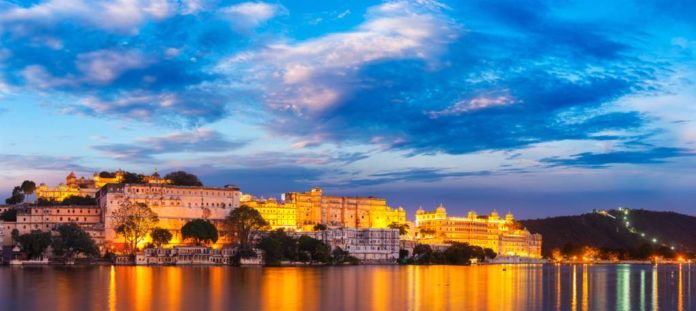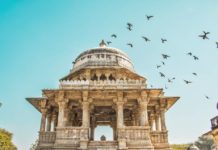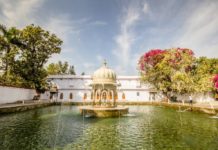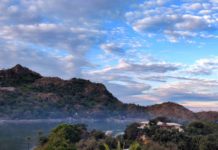Stretched along the eastern coast of Lake Pichola, City Palace in Udaipur is a mesmerizing combination of Mughal-style decorative techniques and Rajput military architecture. Its firm, fortress-like façade, topped by a profusion of elegant balconies, turrets, and cupolas, has been suitably described as a massive plain cake topped with beautiful icing. Built on a hilltop, it has a panoramic sight of the city and its surroundings.
The City palace provides a fabulous view of Lake Pichola which is one of the oldest and the largest lakes in Udaipur. The intricate designs made on sturdy grounds symbolize the roughness and consideration of ancient rulers. The majestic palace reveals a lot about the commemoration and celebration of the people and the prominent strength of ordeal.
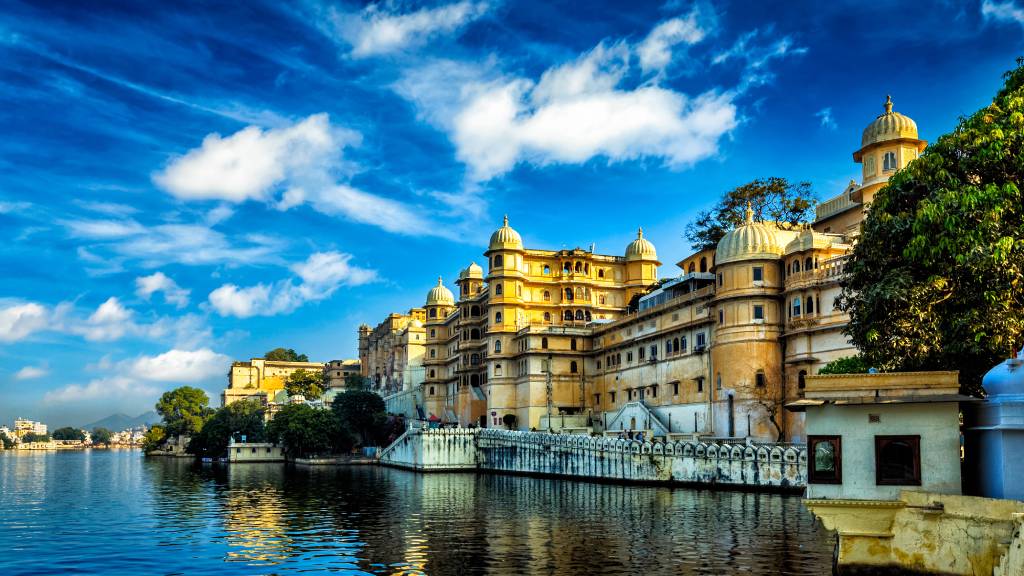
History of City Palace
- During the 8th Century, the capital of Mewar was shifted from Nagda to Chittorgarh which was ruled by the Maharanas for 80 years. Due to the war with the Mughals, Maharana Udai Singh II decided to move the Mewar Capital to Udaipur. He thought Udaipur was a safer place for his kingdom than Chittorgarh.
- Maharana Udai Singh II chose this particular site enveloped by lakes, forests and Aravali Hills as a location of City Palace.
- The idea of moving the kingdom to Udaipur was given by a hermit to Maharana Udai Singh II during a hunting expedition.
- The complex of City Palace consists of several structures where the first-ever structure constructed was the ‘Rai Angan’. This was treated as the Royal Courtyard. After the death of Maharana Udai Singh II, the kingdom was handed over to Maharana Pratap in the year of 1572.
- However, in 1576, City Palace was captured by the Mughal dynasty after they defeated the Mewar dynasty in the battle of Haldi Ghati.
- Although Maharana Pratap valiantly fought the battle of Haldi Ghati against the Mughal Emperor Akbar, they lost the battle as the Mughal soldiers outnumbered Mewar soldiers.
- After the death of the Mughal ruler Akbar, Mewar was handed back to Amar Singh I, the son of Maharana Pratap by Akbar’s son Jahangir.
- In the year of 1761, the Mewar Dynasty once again troubled by the attacks of Marathas. Furthermore, in the year 1818, the Maharana of the Mewar dynasty Maharana Bhim Singh asked Britishers to give protection and signed a treaty for the same.
- In 1947 after the Independence of India, the Mewar kingdom and all the other kingdoms were dissolved and made into one democratic country; hence the Maharanas lost all their sites and powers as well.
- Later the successors of Maharanas retained the properties palaces and transformed them into hotels. The current Mewar Custodian is Mr Arvind Singh Ji Mewar.
Things to Do
After entering the main gate of the City Palace complex known as the Tripolia Gate, there are several other skillfully carved edifices within the palace complex to explore, such as Suraj Gokhda, the Bhim Vilas, the Dilkhush Mahal, the Krishna Vilas, the Mor-chowk, the Sheesh Mahal, the Surya Chopar, Shambu Niwas, the Moti Mahal, and the Amar Vilas opposite to the Badi Mahal.
- Badi Mahal consists of a hall and a swimming pool. It has some of the best miniature paintings from the 18th and 19th centuries.
- The Zenana Mahal which loosely translates as the women’s quarters is well designed with attractions like-coloured windows, tiled walls and floors, balconies, and currently, it has been converted into a museum and is open for public access.
- The Mewar Sound and light show called ‘The Legacy of Honor’ is conducted at Manek Chowk from 7 pm to 8 pm. The experience is a delight to the eyes of the visitors showcasing the great history of Rajasthan in an engaging manner.
- The major part of the complex is the City Palace Museum which displays the history and culture of the Mewar dynasty.
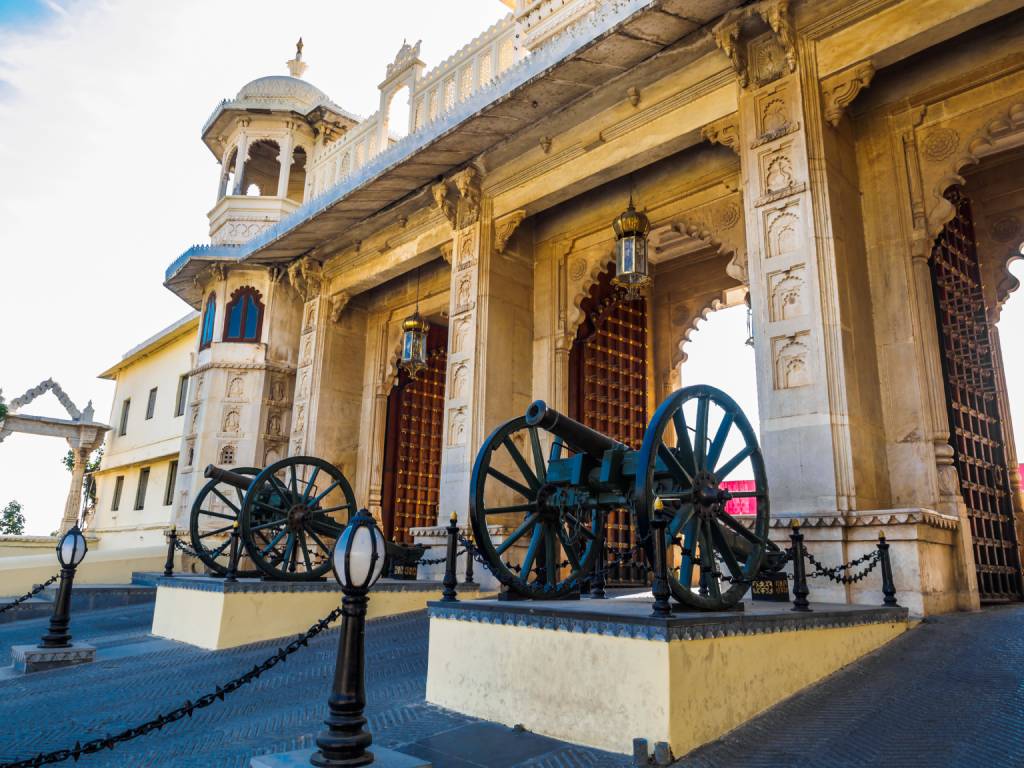
How to Reach the Place
The City Palace is situated in the Old City of Udaipur. You can reach the place using a cab, auto or two-wheeler vehicles. However, the most convenient transport would two-wheeler vehicles or on foot as the area remains very crowded and you definitely don’t want to get stuck in the traffic.
City Palace – Entry Fee
- Entry fee
- Children – 100
- Adult – 300
- Timings
- Opening Time: 9:00 am
- Closing Time: 4:30 pm
Places to Visit Near City Palace
- Jagmandir – Jagmandir Island Palace is located in the middle of Pichola Lake. It is a hotel and a restaurant. However, tourists can also visit it to explore the beauty via boat ride.
- Jagdish temple – It is one of the most famous and largest Hindu temples of Udaipur. One can witness stunning carvings on the walls of this temple.
- Ganghaur Ghat – Ganghaur Ghat is the major Ghat situated at the waterfront of Lake Pichola. One can gaze at the magnificent sight around the entire lake and places around.
- Daiji Footbridge over Pichola – This is a bridge above Lake Pichola which captures a mind-bobbling view of the Lake, Jagmandir as well as few parts of the old city.
- Bagore ki Haveli – It is a museum situated at Ganghaur Ghat. The entry fee is INR 60 and an additional INR 100 if you’re carrying a Camera. Every Wednesday between 7-8 pm, the Dharohar folk dance show is organized here with no additional charges.
- Ambrai Ghat – Another Ghat situated at the banks of Lake Pichola. It is a perfect relaxation spot, and an ideal destination for photography as the view is mind-blowing.

